
Recumbent bikes with bodywork evoke a curious effect. They look as fast as a racing car or a jet fighter, but of course, they’re not. Nevertheless, thanks to the recumbent position, the minimal weight and the outstanding aerodynamics, pedalling a “velomobile” requires three to four times less energy than pedalling a normal bicycle.
This higher energy efficiency can be converted felt in terms of comfort, but can also be utilised to attain higher speeds and longer distances - regular cyclists can easily maintain a cruising speed of 40 km/h (25 mph) or more. The velomobile thus becomes an excellent alternative to the automobile for medium distances, especially in bad weather.
Basically, a velomobile is a recumbent bike with the addition of a bodywork. Recumbent bikes are considered a bit weird, but they have some interesting advantages over normal bicycles. For example, a recumbent bike has no saddle but a comfortable seat with back support, so that you sit or lie more comfortably and can keep pedalling for longer. Because of their superior aerodynamic capabilities, pedalling on a recumbent takes less effort, allowing you to travel more quickly and further than on a normal bicycle. Recumbent bikes can have two, three or four wheels. Trikes (3 wheels) and quads (4 wheels) offer the additional benefit of stability.
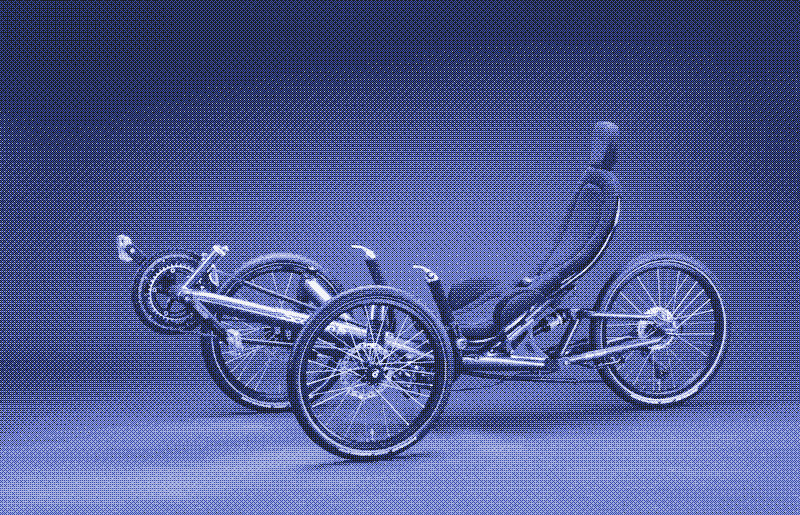
A velomobile - almost always a trike - offers two extra advantages over normal recumbent tricycles. The bodywork protects the rider (and mechanical parts) from the weather, so that the vehicle can be used in any season or climate. Furthermore, the aerodynamic shape of the bodywork further improves the efficiency of the vehicle, with spectacular results.
Velomobile versus bicycle
From the table below (source) one can observe that the power output required to achieve a speed of 30 kilometres per hour (18.6 mph) in a state-of-the-art velomobile (the Quest) is only 79 watts, compared to 271 watts on a normal bicycle and 444 watts on a neglected bicycle. Pedalling at a speed of 30 km/h thus requires 3.5 times less energy with a velomobile than with a normal bicycle. Going flat out (a power output of 250 watts) gives you a speed of 29 km/h (18 mph) on a normal bicycle and 50 km/h (31 mph) on a velomobile.
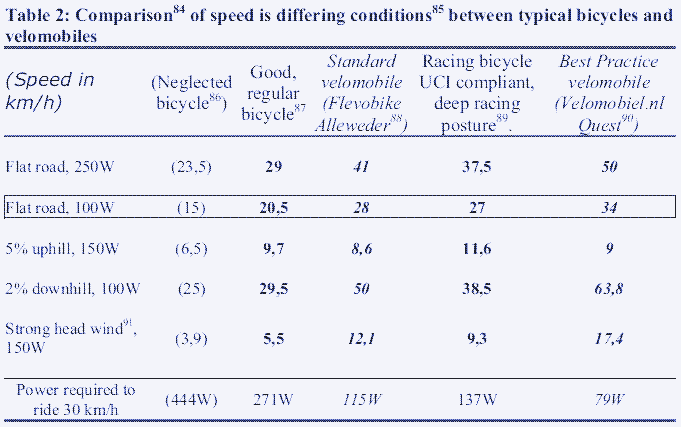
NASA rates the average long-term power output for a male adult at 75 watts, while fit individuals might easily sustain more than 100 watts for several hours, from 200 to 300 watts for one hour, and between 300 and 400 watts for at least 10 minutes. Lance Armstrong is said to have averaged between 475 and 500 watts for 38 minutes during an uphill climb in the 2001 Tour de France. (Source: The human powered home).
If you normally commute by bicycle, you can do two things with a velomobile: Retain the same speed as you normally do, but use 3.5 times less energy, or arrive at your destination twice as quickly with the same effort. This high efficiency greatly enlarges the range of a pedal powered vehicle. The bicycle is generally being viewed as a transport means for short distances, mostly below 5 kilometres or 3 miles (= cycling 15 minutes at a speed of 20km/h or 12.4 mph). However, the average distance of a car trip in Europe and in the US amounts to between 13 and 15 kilometres (8 and 9.3 miles).
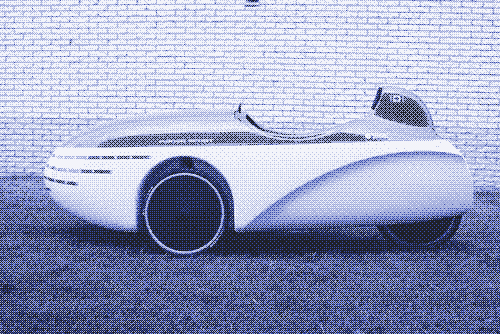
A velomobile reaches a constant cruising speed of 35 km/h (21.7 mph) with the same energy output, so that the distance covered in 15 minutes becomes 9 kilometres (5.5 miles) instead of 5 kilometres (3 miles). At a speed of 45 km/h (not unusual for a regular cyclist) the distance covered in 15 minutes becomes more than 11 kilometres (6.8 miles). Thus, twenty minutes of pedalling on a velomobile sufficiently covers an average automobile trip. The velomobile could replace a substantial portion of car miles, especially because the vehicles also protect their occupants from wind, rain and cold.
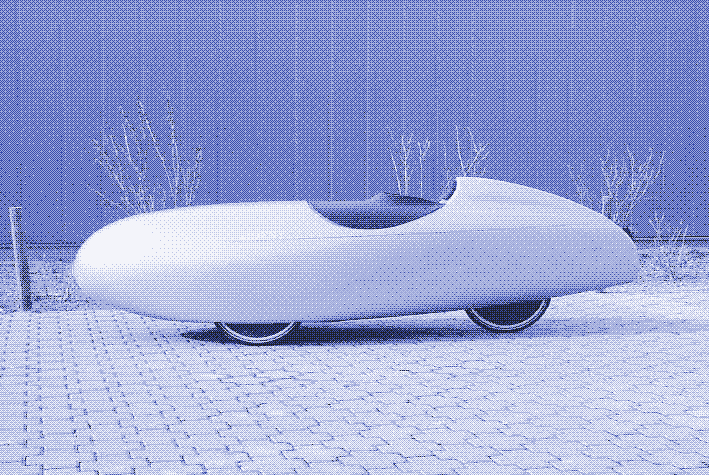
By definition, velomobiles are built for speed. The bodywork offers a distinct advantage at higher speeds, starting at 20 to 25 km/h (12.4 to 15.5 mph). Above those speeds, almost all energy produced by a cyclist is channelled toward combating air resistance. Because of the upright position, the aerodynamics of a cyclist on a normal bicycle are disappointing. A velomobile, on the other hand, suffers less air resistance than even the most aerodynamic sports car.
At lower speeds, however, the relatively heavy (25 to 40 kilograms) velomobile becomes a disadvantage. It accelerates slower than a normal bicycle, and has considerably more difficulty climbing a hill. An electric assist motor can solve this problem in hilly regions. The motor can help the velomobile climb, while energy can be recovered from the brakes during the descent. Of course, an electric assist can also be considered on flat terrain, an option that is gaining a lot of popularity these days.

By definition, the velomobile is essentially built for longer distances. For shorter city trips the traditional bicycle is unbeatable. It accelerates faster, it is more manoeuvrable, and it is very easy to hop on and off.
Velomobile versus electric car
Dries Callebaut and Brecht Vandeputte, the Belgian designers of the WAW-velomobile, calculated how the efficiency of a velomobile relates to the efficiency of an electric automobile (using their own data and this source). During an eco-marathon earlier this year they equipped their velomobile with an electric motor, a complete substitution for pedal power. This is not really what the vehicle is intended for, but the advantage of the experiment is that it allows for an unequivocal comparison.
The energy consumption of the WAW was measured at 0.7 kWh per 100 kms (62 miles). This makes the velomobile in excess of 20 times more efficient than electric cars currently on the market. For example, the Nissan Leaf requires 15 kWh per 100 kms. The enormous difference is of course due to the enormous difference in weight. Without the battery, the Nissan weighs just over a ton, while the WAW weighs less than 30 kgs.
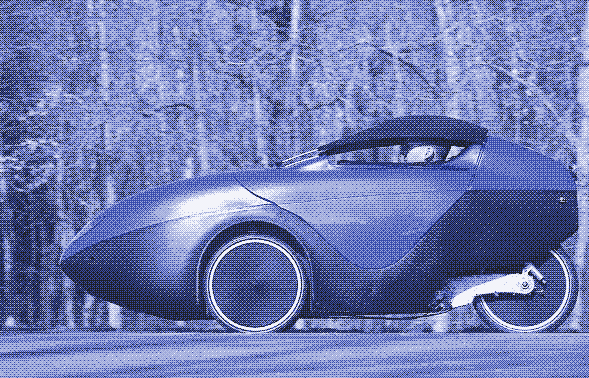
For a human powered velomobile the comparison is a bit more complicated and open to interpretation, because a human does not run (primarily) on electricity, but on biomass. The efficiency of a human powered velomobile thus depends on what the cyclist eats (the efficiency of an electric car also depends on how the electricity is generated). Callebaut and Vandeputte set the primary energy use to 0.6 kWh/100 km for a vegetarian diet from your own garden, to 2.4 kWh per 100 km for the average diet of the western non-vegetarian.

A human powered velomobile is thus 15 to 62 times more energy efficient than a Nissan Leaf. Not just 6 to 25 times, because we are comparing primary energy here. The 15 kWh that is consumed by the Nissan equates to around 37.5 kWh primary energy since electricity plants (in Europe) have an efficiency of 40 percent.
You can also argue that burning fat is a positive thing regardless of where food comes from, since obesity and a lack of exercise are endemic throughout the western world. The energy that is now being wasted in fitness centra, or the fat that is hanging in front of the television, could be put to good use as an oil substitute in transportation. In this view, the velomobile consumes (just as the cyclist and the pedestrian) 0,00 kWh per 100 kilometres.
Origins
The origins of the velomobile can be traced back to the beginnings of the twentieth century, but the modern, streamlined velomobile only appeared in the 1980s. The first commercially available velomobile was the Danish Leitra. In 1993, the Dutch Alleweder appeared on the market. About 500 of them were were sold in the Netherlands, Belgium and Germany throughout the 1990s.
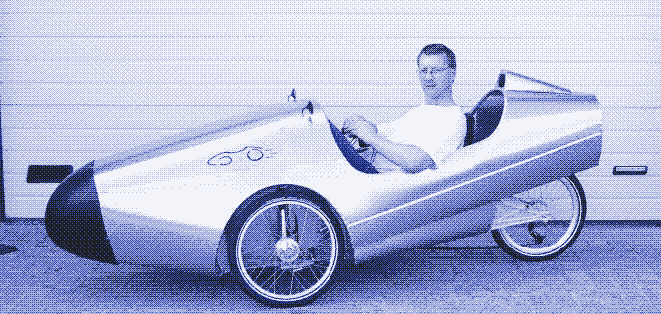
The Alleweder introduced an important technological innovation: the self-supporting, monocoque coach work, similar in construction to that of a car - though much lighter. This gave the velomobile a sturdier construction without weighing it down. The suspension system introduced by the Alleweder was also inspired by automobiles. The bodywork of the original Alleweder is made from aluminum plates riveted together, a technique inspired by airplane builders.
With or without a roof
All velomobiles produced since then are based on the construction principles of the Alleweder. The only difference is that the bodywork no longer consists of aluminum but is made up of composites (like Kevlar). These materials are more expensive, but offer more freedom in designing the fairing, allowing for better aerodynamics.
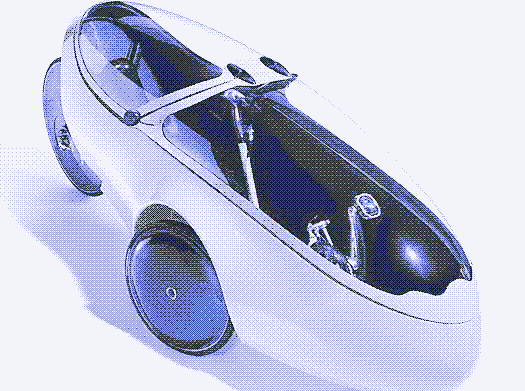
A modern velomobile weighs between 24 and 40 kilograms, is about 250 centimetres long, 80 centimeters wide and 95 centimetres high. The three wheels have suspension and the bodywork has integrated rear view mirrors, head lights, indicators and (sometimes) brake lights. A velomobile also has a luggage compartment comparable to that of a sports car.
The present-day velomobile comes in two varieties: vehicles in which the head of the driver sticks out (like the Quest, the WAW, the Versatile, the Mango, the Velayo, and the Alleweder) and vehicles in which the driver is fully enclosed (like the Go-One, the Leiba, the Leitra, the Pannonrider and the Cab-Bike). In the case of a fully enclosed vehicle, part of the bodywork can be opened to get in and out. In a half-open velomobile, the driver enters and leaves via the hole where the head sticks through.
Velomobiles can have open or closed wheel arches. Closed wheel arches give better aerodynamics but they make the turning cycle larger and hamper the changing of a tyre.
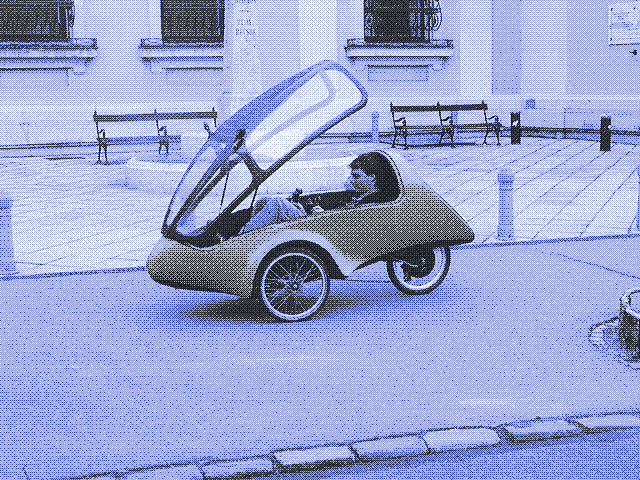
Fully enclosed velomobiles give the best protection against bad weather, of course, but they do carry a few disadvantages. The main problem has to do with ventilation. Even in cold weather, the driver may “overheat”. A body that delivers 200 watts, produces around 1000 watts of waste heat, which mostly escapes via the head. In a fully enclosed velomobile hearing and sight are also affected. The windshield can steam up or it can become opaque because of rain or snow (windscreen wipers are not an option on any velomobile, probably because of the extra weight that would be added by motor and battery).

A fully enclosed velomobile thus needs an efficient natural ventilation system (which can happen via air intake in the nose of the vehicle). Some manufacturers have come up with a compromise. The WAW has a small optional roof with a ventilation system that can be manipulated from the inside of the vehicle. It can be quickly installed and it fits in the trunk when folded up. The Versatile also has a smart roof, bypassing the heat and ventilation problem while still protecting the rider from the rain.
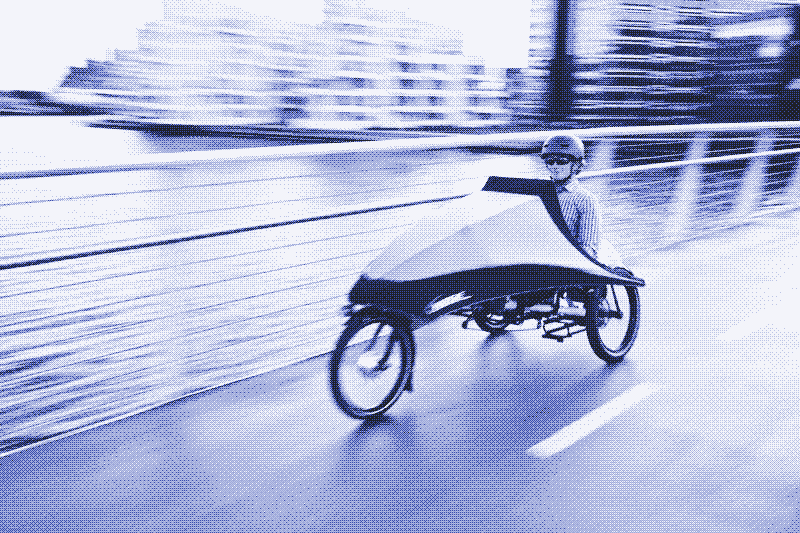
The German manufacturer Hase recently presented a recumbent tricycle with a foldable fairing (and an electric assist motor). This is not a compromise between a fully or a semi-enclosed velomobile but between the latter and a normal recumbent trike - the most comfortable and aerodynamic option in warm weather.
Two-seaters
Recently, some two-seater velomobiles have appeared, such as the Bakmobiel (a cargo bike) and the DuoQuest. The essential idea is that occupants sit next to each other. It’s good to see that cosiness still beats aerodynamics.
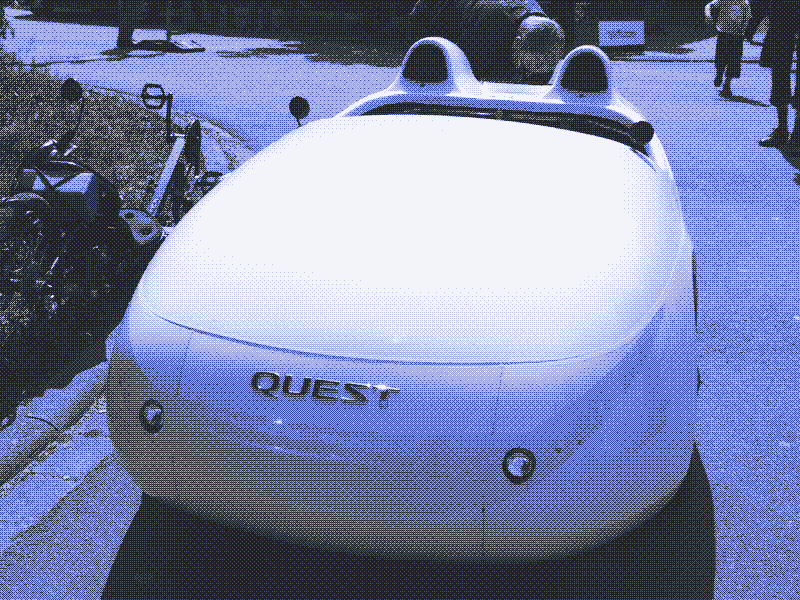
Another recent trend are velomobiles that have been especially designed to easily hop in and out of. The adapted design lowers weather protection and aerodynamics, but the result is still a more efficient bicycle at higher speeds, which comes in handy for shorter distances.
Are velomobiles too expensive?
The high purchase price is often mentioned as one of the largest obstacles for a breakthrough of the velomobile in the mainstream market. A fully equipped machine will cost you at least 5,000 euro (6,700 dollar) - considerably more than what you pay for a good quality bicycle. In the US prices have come down from a level twice as high, since now some of the popular Northern European brands are also produced in the States. Shipping a velomobile across the Atlantic is not cheap.

The high price stems partly from the surcharge of a recumbent, but mainly from bodywork. Each velomobile is hand-crafted, with the fairing requiring the most work. It would of course be cheaper to produce velomobiles on an assembly line, especially when this would happen in a low-wage country. But even then - including social exploitation and extra environmental costs - nobody expects to see a velomobile sold for less than half the current price. Lightweight materials, crucial to make the technology work, just happen to be expensive.
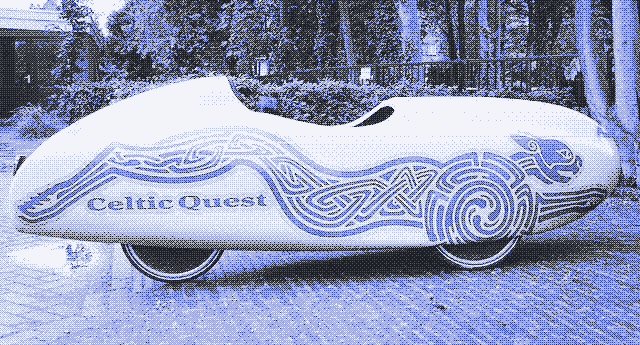
You can look at it differently, of course. A velomobile is more expensive than a bicycle, but it is cheaper than an automobile. Since the performance and the comfort are also in between that of a car and a bicycle, the price starts to look more reasonable. Moreover, a car requires fuel, and a velomobile doesn’t. Maintenance is limited to changing the tyres. Whoever changes his or her automobile for a velomobile is definitely making a economical decision. Governments could help overcome the purchase price by financially supporting velomobiles instead of electric cars and biofuels - at least their ecological gain is clear and they don’t need a completely new charging infrastructure.
Alternative to the automobile?
The most important obstacle for the velomobile is not the purchase price. It is the competition of the automobile. Although a velomobile can ride on a wide enough bicycle path, because of its larger dimension and higher speeds the vehicle is more suited for the road. The concept of the velomobile is sound as long as the vehicle does not have to share the road with automobiles. On current roads, piloting a velomobile would be relatively dangerous. Car drivers don’t always see you, and in spite of the many strengthenings in the bodywork you are very vulnerable against, say, a Jeep Cherokee.
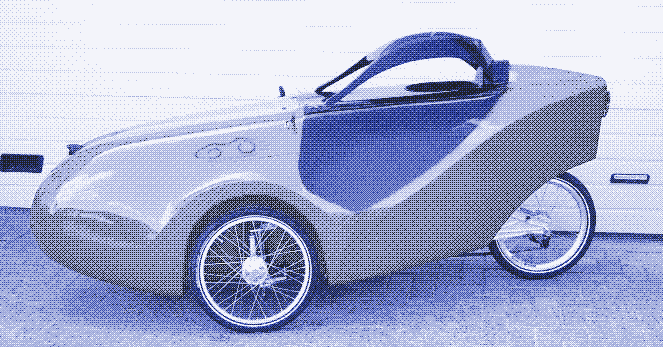
A breakthrough in the velomobile thus requires either a completely new infrastructure for pedal power, or the substitution of velomobiles (and other human powered vehicles) for automobiles on the existing local and regional road system. The latter option, which I prefer, would not be conducive to car sales, but there is nothing or nobody that stops car manufacturers from producing velomobiles.
Reactions
To make a comment, please send an e-mail to solar (at) lowtechmagazine (dot) com. Your e-mail address is not used for other purposes, and will be deleted after the comment is published. If you don’t want your real name to be published, sign the e-mail with the name you want to appear.
Reactions
Andy
I love the concept of velomobiles. As someone that bikes to get anywhere that’s within 100 miles, I could certainly see myself getting a velomobile one day to make those longer trips easier. 100 miles by upright bike takes me around 8 hours, although when riding daily distances like that while touring I tend to average about 10mph including all stops and breaks. I would expect a velomobile to increased that average overall speed to about 13mph touring, or 22mph sustained for a single day of riding (based on 33% increase speed).
There’s three big reasons why I don’t currently own one though. About 45% of my annual miles are from commuting, 35% riding with groups, and 25% riding long distance alone. The commute would not be better on a velomobile since it has traffic lights and lots of cars to deal with. I would not want to be low to the ground, with limited vision, while riding through the city. For the group rides, being enclosed and low would mean that I’m not able to socialize very easily, which is a big part of why I go on those rides. That leaves 25% (about 1200 miles) that could be ridden on a velomobile. It just doesn’t seem worth $5000-$10000 for a vehicle that only goes that far in a year. Only accounting for startup costs (lets assume $6,700) and assuming it lasts 3 years before I sell it at half the costs (my current assumptions for buying bikes), that would be about $1/mile. Between my current road bikes, I only pay about $.30 per mile, so the velomobile is certainly a bigger cost.
To answer your question of whether it’s a high tech bike or a low-tech car, I think it’s kind of neither. It’s not well suited for biking around town OR for going >100 miles. I still own a car because I take trips to see family in various places several times per year, so I need a way to get 200-400 miles in a reasonable time still. So at least for me, at this time, a velomobile would just be an expensive addition to my “fleet.”
I did consider buying a used recumbent for about $650. With a few hundred dollars of materials, I could make a fairing for it that would make it a primitive velomobile. That’s the most likely option for me, but still an investment I’m not yet ready for.
glen murry
The lack of windshield wiper option is additionally likely due to the use of polycarbonate or other plastic windshields which would become quickly scratched by the wiper blades to the point of opacity
Guilhem
Your article is great, it is rare to see an article that depicts so well what a velomobile truely is.
But I jumped out of my chair when I saw your last sentences ! I preferred the velomobile over the bicycle because it is much safer on the road with automobiles, especially out of cities ! Motorits give plenty of room to velomobiles when passing by, and they are much more cautious than with a regular bicycle !
Velomobile can definitively be used on the road, among cars, provided that it is equiped with good lighting and visibility items.
Suman Mitra Subramanian
I’ve been considering a velomobile for a while now to extend my bicycle commuting season, and this page provides an excellent summary of their pros and cons. Where I live (Phoenix, AZ area), summer afternoon temperatures can be over 110 F (43 C), while winter morning temperatures can be around freezing, so I would like an open model that can have a closed canopy attached during cold/wet weather (we get very heavy rain during the summer monsoon). Also, it would need to look good! I hope prices come down, especially for the sleeker models.
Thanks for compiling this information!
jamesmallon
Hate to piss in the cool-aid you’re drinking, but velomobiles ain’t moving out of the fringe. Tried to explain the obvious reasons, but you clearly don’t want to hear. Enjoy trying to popularize them, if you don’t think you’ll get discouraged.
Kris De Decker
@ Brian:
The weight issue can be solved by an electric assist motor, see http://www.lowtechmagazine.com/2012/10/electric-velomobiles-as-fast-and-comfortable-as-automobiles-but-80-times-more-efficient.html
Cramped? Manufacturers of velomobiles have started to offer different sizes, both for shorter and taller people. (like the WAW Extra Large that I test drove, see the link above).
Your last point is valid. A velomobile is not very well suited for a hot climate. Ventilation helps (and is generally included) but what you need for cycling in hot conditions is a non-faired cycle. As much as I love velomobiles, I am not driving one in real life exactly for this reason (I live in Spain).
Will Stewart
Kris, this represents one of the most promising modes of transportation available where mass transit is not available. Kudos on highlighting these. If there were one technology to reduce our dependence on foreign oil (or institute sustainable transport) in the suburbs or even transit-challenged cities, this would be it.
Do you know anyone with one of these (or are you game enough to try one out yourself)? Please continue reporting on this topic, it’s that important…
Paul Nash
Great article Kris! I have seen many recumbent bikes, but only ever two velomobiles (from the back, as they passed me on my bike). It seems to me a natural evolution for a recumbent to add the fairing.
While the examples given use exotic materials like Kevlar, that does not mean they have to. You can build them out of wood, using the same techniques for making canoes, either with marine/aircraft plywood, or in cedar strip style. And this fellow has done just that (this is actually a tandem velomobile!);
http://picasaweb.google.ca/lh/photo/TddLbh0J2_6yg9aEgdBPFA?feat=embedwebsite
or this;
Some good examples of old style, wooden, velomobiles from the 30’s and 40’s here;
http://www.mochet.org/Velocars/velocars.html
Having built my own cedar strip canoe, I can vouch that it is lighter (and better looking) than any fibreglass one, and cheaper than any kevlar one. It would be easy to make a kit that the velo owner builds themselves - this is widely done for canoes/kayaks - and allows for flat packing!
The power/speed numbers are interesting, as you can compare to what you would get on an electric assist bike, which I think is what you need if you are going to use the velomobile in traffic. Here in Vancouver, Canada, bicycles are allowed 500W of electric assist, and maximum speed of 32km/h. Assuming that you have the “standard” velomobile, and allowing 150W average power, a 3kg Li-ion battery pack would give you two hours and 64km of range, and more if you pedal.
However, I think for velomobile to catch on as a serious means of transport, they will probably become “electric scooters”. The rules here are up to 1500W, maximum speed of 72km/h, max weight 90 kg, not incl rider or batteries, must be registered and insured, and rider must wear a motorcycle helmet. pedal power is optional. You could easily design a velomobile to those rules that would keep up with all but freeway city traffic, and it could be strong enough to give you some crash protection (safety cells on F1 cars are less than 50kg and good for up 150km/h crashes).
For electric vehicles, these are the ones that make sense - light and aerodynamic and affordable
Michelangelo Du
Dear Mr. Decker, I hope you don’t mind, I just want to comment from a Philippine perspective, where we have many types of alternative relatively inexpensive transport from the Jeepney, the Electric Jeepney, the Tricycle, The Trisikad, The Motorela and the habalhabal; You will notice that most bikes here are not recumbent, and travel only on traffic ridden streets where they have the advantage. For climbing uphill, bikes and recently, electric bikes, are available right now. Thailand has its own version of The Motorela which is called the Tuktuk,electrically powered. None of Bicycles here seems to use a recumbent chassis, and if ever we need to go high speed, we can take a commute thru a the Jeepneys, Trisikads, Motorelas or as some of my friends do, travel on an electric bike or motorbike, on the main roads (there are no freeways here).
I find this blog of your quite interesting since it features out of the box, but practical, inventive solutions to world problems.
Best Regards, Michelangelo “Mike” Du
For your reference:
the Jeepney
http://en.wikipedia.org/wiki/Jeepney
the e-jeepney
http://www.greenpeace.org/international/en/news/features/filipino-jeepney-green-energy-050707/
The Trisikad
http://crankandpedal.wordpress.com/2007/08/09/we-have-our-trisikad-ny-has-bicytaxi/
The Motorela
http://www.photo.net.ph/displayimage-3505-135.html⟨=arabic
The Habalhabal
http://istambay.wordpress.com/2008/09/27/1343/
This is an electric bike similar to those recently being sold in the Philippines
http://www.ecvv.com/product/934181.html
Rick
They don’t look like they’d handle potholes very well. Unfortunately most of our roads are not so great.
The other thought I had was are there any races featuring these? Could they run on automotive race tracks? Maybe with sponsorship, athletes, and some exciting drama, the manufacturers of these things could build up some good publicity and recognition. “The Daytona Velomobile 500”. “NAS-Velomobile”. etc…
G Frank
“The concept of the velomobile is sound as long as the vehicle does not have to share the road with automobiles. On current roads, piloting a velomobile would be relatively dangerous.”
I think that statement is sorta silly. I DRIVE my recumbent trike on the street and use the right traffic lane safely with cars seeing and changing lanes to share the road with me even in car-obsessed southern California. I think that trikes and velomobiles are actually more visible and noticed… and maybe safer than riding a conventional bicycle on the side or sidewalk of a road.
Per Hassel Sørensen
I use an Alleweder that I built from a kit. It works nicely, no problem with cold weather like we have here in Norway in the winter.
The speed is too high to go fast on bike/walk paths, the road is best for a fast commute.
My Golden Motor Magic Pie motor assist uses 5 wh/km in average, and my motor is regenerative improving range approx 40% on long trips, 20% on short ones (then I brake less). With 36V battery (1.3 kg Li-Po) I have a top motor speed of 26 km/h which is within the 25 km/h (+10% tolerance) European Pedelec legal speed.
Highly recommended transport if you do not want to get wet but still want to ride a bike for exercise even in rain or snow.
Daelach
I live in a big city, and bike theft is a major problem. I do store my Brompton folding bicycle in the kitchen, and I put my other (conventional) bicycles in the cellar. But carrying a velomobile downstairs and upstairs? As awkward (for carrying) as it is, and as heavy?! No way.
Another point is that the lining is quite easy to damage - and not that easily repaired.
IMO, you underestimate the weight problem. There is a big reason why those machines are most common in the Netherlands and Denmark: both are flat. You won’t catch up the time downhill that you lost uphill because the slowest parts in the journey determine the average.
Overmore, a velomobile only gives advantage at higher speed - nothing with “same speed, 3.5 times less power”. The linear rolling resistance is at least just the same. Or higher, because of the camber which also tends to rub down the tyres considerably faster than with normal bicycles.
And if you consider the price of these things, just calculate how many hours of additional work you need. Same as for cars - the “social speed” is lowered by the costs.
Or, try to take a velomobile aboard a train. Sounds funny..
Anon
Nice ongoing discussion! These things wouldn’t need windshield wipers if the windshield can be treated with Rain-X or a similar surface treatment or water repellent. Would WD-40 work?
Jake
@Andy One could set up simple fm two-ways where you could still communicate within 300 metres, for all your social rides
mi7d1
A group of velomobiles are leaving tomorrow (28 July 2011)for a cross country tour from Portland, Oregon to Washington DC. Riders come from six countries. Twenty-two Europeans and twenty-six N. Americans. They plan to average 200km (124 miles) a day.
http://www.rolloveramerica.eu/
Gerd Z.
Clear & positive text, I really like it. I recommend people this article if they wish to know more about velomobiles. If only they could be somewhat less expensive…
B. Trost
To answer the lead question: Low-tech sports car. And, like some sports cars, your typical velomobile doesn’t appear have room for a briefcase, let alone a bag of groceries. Getting there fast is OK – getting there with dinner fixings is much more useful.
Jay
I love this tech and I look forward to the future iteratons that will come. I think one great addition to the velo would be a flywheel system that could store energy much like a KRS in an indy car. This could normalize the pedaling input and greatly assist in launching from a stop. With this and a few other improvements it could be a better option for some. Like most of those who posted here the velo is not for everyone but there is a place for them and you have to admit they represent interesting tech.
Grant Connor
This is an excellent article and the velomobile with electric assist may prove a useful option if room for cargo or child seating is included. For most of us the fully faired upright bike offers more flexibility at lower cost. A 26" ladies'3spd geared 40/19T with a curved coroplast front fairing and rectangular Rubbermaid trash can tail box is truly low tech and affordable. We do not live in a “one size fits all” world. Find what works for you.
Paul B
The last thing velomobiles need is a government subsidy, which will ruin the industry. Instead, subsidies of automobiles need to be removed, as do government zoning laws which mandate separation of residences from work. Anyway, they will stay on the fringe until the price of gas goes significantly higher, which it is bound to do. But the cost of production will have to come down; otherwise it will remain squeezed to a tiny segment of the market between small motorcycles and ordinary bicycles.
seb
@Rick (#13) Yes in Adelaide, Australia they have the ‘24hr Pedal Prix’ every year. With hundreds of ‘velomobiles’ and thousands of spectators. Shame we don’t have it here in the UK.
superkaos
And exactly why would it be dangerous to ride one of these on the road? What type of risk would get increased as to driving a motorized vehicle? I think it is kind of silly to think that one would need to separate these vehicules from motorized cars. Just like a bicycle does not need any special “facilities” to be ridden safely, quite the contrary, those “facilities” make riding more difficult and dangerous. Please, let’s be more rigurous and not fall for the same old myths, fears, and superstitions about cycling.
Corey
A simple velomobile is a nice concept but I would prefer to have a two person velomobile with an electric assist motor and decent storage and a regenerative breaking mechanism.
I think the realistic requirements to make this technology more popular is higher speeds, safer, multiple passengers, ample storage, cost effective, and attractive design. Also, I think it would be important to have the option of pedaling to power vehicle, using electric motor, or using combination. I have considered building one and I have some concept designs. At this point I would need some assistance in cost and building.
Tad Ermitano
Just a thought: windshield wipers could be run via a mechanical linkage (clutch, leaf spring, etc) to the pedals
Amit Baum
Hi,
I am now working with a group of Master students on a eco-city around Shanghai region. We are straggling with the concept of cycling highways: how to create a cycling grid without traffic lights combined with a top priority pedestrian sidewalks? I am a cyclist myself (no drivers license) with broad touring experience (South America and Europe). If you think it is really possible please share your ideas with us. This is an academic project, but the project is very real and the budgets are huge, even in the Chinese scale. Our deadline is around May 2012, but you are welcome to contact me at anytime, as I am really curious to find a way to make this utopian dream come true.
Amit.
Baum.Amit@Gmail.com
Skype: baum.amit
SHOHAMIT.freevar.com
Bob Fairlane
I like velomobiles very much, but I think they will remain rare in the US until drug abuse and reckless driving are reigned in somehow. Ignorance costs America untold fortune and happiness. It’s not hard to see a velomobile from a car, but many car drivers are just plain high or stupid, and they feel entitled to be “first” everywhere they encounter a bicycle. I think the best substitute for a car is a motorized bicycle, the best of both worlds, and which can travel in both bike lanes as a bicycle, and car roads as a sort of “moped”. I am reading up on motor assisted velomobiles now, as I think a faired motor bicycle could get very high mileage and easily travel 30-40mph with little strain on the legs or the motor.
Uwe Goerlitz
Hi,
for the discussion about windshield wipers: The Leitra offers a simple manually operated wiper and the german dealer for Leitra developed an even lighter and simpler wiper (http://www.mikusliegerad.de/html/leitra_updates.html ) I personally use this carbon-wiper with good results.
The wipers are working on a Leitra, because the Leitra uses a classic flat glass panel as the central part of the windscreen.
The need for wipers isn’t really that big. e.g. in central europe we’re facing precipitation approx. 10% of the year, so roughly every 10th ride will see water on the bike and not every ride in the bike requires the wiper.
Other climates will probably have a bigger need.
My own experiences with velomobiles in moderate climates (winters with temperatures down to -15°C and summers up to 39°C) show the need for small windows on a velomobile. (a Go One 3, Pannonrider or Twike will work as a glasshouse boiling you on the go) In the Leitra with it’s small windows I still feel comfortable and don’t want to switch back to an open bike / recumbent bike in summer. It’s more comfortable even in 39° in the Leitra than it was on any other bike I used during the years.
The biggest disatvantage I noticed so far is a difficult communication. I can’t talk to other cyclists while riding a velomobile. I have to stop for conversation. An open velomobile (Versatile / Orca) is preferable in those cases.
Pricing of velomobiles is still a problem. Prices will fall when numbers are increasing, but numbers will not increase as long as prices are so high.
For a very good overview over the current state of recumbent bikes and velomobiles it’s a good idea to visit the annual special bikes show in Germersheim / Germany. ( http://www.spezialradmesse.de/index.php?welcome )
Brennan
I’d like to see photos or video of someone 2 meters or 6'6" Tall getting IN & OUT of an incumbent and fairing. When I’v ridden a “sit on top” kayak [the only kind I & my shins’ll trust], my legs Must Be strait and flat-out, this puts my ankles Over the foot mounts, this is awkward & uncomfortable, but the rest of me feels balanced and well …comfortable :) Also if the seat reclined into a flat [2 m] bed! and it floated? well then I’d have to have one ;).
Vivek
I have seen these bikes on tv, mostly on discovery channel. Can anyone build it at home? Or they are too hitech? I live in India. If I want to get velobike, where I can get it? Or can you post any article on building a velobike? Please do it. Thank you.
Brian
I like the concept of velobikes, but like trained beer opening monkeys they aren’t practical for most people. They are small and slightly cramped for anyone over 6 feet tall unless you have the cash for a custom bike, though this is a general problem with all recumbents. The other problem with the velo is the weight issue, beyond hills you also have the constant stop and go of traffic which seems as though it would wear most people out. The last problem that I see is probably because of my location in Florida, USA, it just doesn’t seem to have much airflow to cool the rider. Especially when I see that enclosed model, I can just imagine being trapped in that thing at a stoplight with the temp near 100 degree F and the humidity levels climbing past 90%. Hello heatstroke.
So just get the sizing bigger and cheaper, regen system for traffic, and some ventilation for riders and I will be right behind you.
Mr.Clifford Charlesworth
As a motorist I am becoming more familiar with these types of vehicles on our roads & I am surprised to read all these comments about how good these pedal powered vehicles are i.e.- speedy etc . & yet I see nothing about the capability or competence of the person driving the vehicle. As these vehicles are used on the road I suppose they are subject to the
Rules of the road& in my opinion the driver should be in someway assessed as to their knowledge of the Highway code` & ability & competence to drive or pilot the vehicle. Just a thought . If car drivers & motorcycle riders have to pass a test then I believe so should the drivers of these vehicles if they become road users.Cliff Charlesworth
Wolfsbane
I’ve discovered the magic bullet that make velomobiles desirable and functional.
Instead of a large battery pack, install a self contained portable emergency generator. Install a couple of batteries that move it around slowly when the generator isn’t running to further the ruse that the vehicle is battery powered and the generator is just carried for emergency recharges and running lights at night.
You can find them up to 8000 watt sizes for around $600usd at places like discount tool purveyor Harborfreight. Their biggest generator fits in a compact 30"Lx27"Wx24"H compartment. Less capable ones are smaller.
Then replace the anemic electric assist motors with a Briggs & Stratton Etek or equivalent. It’s unfortunately not made anymore but there are substitutes.
You can easily make these light vehicle keep up with the average automobile. So I’d recommend upgrading to narrow motorcycle tires instead of bicycle tires.
Just don’t get caught and don’t be obvious about it. I’d suggest laminating a thick fabric covering like felt to the velomobile’s body to make it less visible to police radar.
www.Harborfreight.com
www.briggsandstratton.com/us/en/support/faqs/availability-of-the-etek-motor#
Andrew
Velomobiles are fun (for those of us who are children at heart), and bar none, the most efficient form of transport.
Unfortunately, they are also extremely impractical as it is dangerous to share the roads, and dedicated high quality infrastructure is basically non existent except perhaps in some regions of the Netherlands.
Meanwhile, I’ll do 90% of trips around my city on my high powered upright ebike.
Grant
RE POST 41 ABOVE PLEASE REMOVE IT FOR THE FOLLOWING REASONS
CARBON MONOXIDE is a silent, odourless, colourless, KILLER !!!
THERE ARE NO SECOND CHANCES!
Never operate a generator nearer to any person than the manufacturer recommends. Even with this precaution, people have been killed in tents by the CARBON MONOXIDE drifting in to the tent or even open windows of their homes. ALWAYS CONSIDER THE WIND DIRECTION! NEVER LEAVE A GENERATOR UNATTENDED NEVER GO TO SLEEP WHILE RUNNING!
To suggest carrying one in velomobile is to invite DEATH!
Commercial vehicle generator installations have to be thoroughly safety checked, usually with extended exhaust systems. Just as gas installations have to be checked by a competent person for the same deadly reasons.
Jiro
Oooh, Velomobile! or as I remember from long ago, Human Powered Vehicle. As a passionate believer, I extolled the HPV approach to remaking our cities. I was crushed when a road racing cyclist bashed the recumbent/HPV. Of course I promoted the bicycle freeway, separated bike lanes, etc. I took Effective Cycling, but get real, large numbers of American parents aren’t going to pedal their kids to school without dedicated cyclist space on the streets. Now in a comfortable if decaying middle age, I have space in my garage and money for a road bike, commuters, an extracycle (long cargo bike), a trailer, etc. Recently I bought an F40, a fully streamlined recumbent, my dream of fast pedal travel for years. Alas, I find the position alarming in traffic! Low and less easy to look around, less free to jump off. On the plus side, the braking is vastly superior. So far I have not used the fairing, but clearly the utility of the diamond frame in town is evident to me. I do hope that as cities adopt Vision Zero and reduce traffic dangers, recumbents and velomobiles will feel safer. Certainly the size and weight of the velomobile or a faired recumbent would make anything other than garage parking a serious chore. My current technological fantasy is a streamlined reverse trike with tilting front wheels and an electric motor. Suburban commuters might like that. I think that the motor makes the tilting front wheels more appealing. thank you for the great write ups. Who would have thought that indoor cigarette smoking would become illegal and cycling would become so popular!
William White
When visual and physical handicaps made bicycle riding difficult and unsafe for me I switched to an ELF from Organic Transit. https://organictransit.com
Green Wizard
What is tha maximum weight possible of a Velomobile?
anyone got an idea… i intend to motorize one.
berne
Why would a recumbent position require less effort? in either position your weight is being supported by a seat.
The disadvantege of the recumbent position is any ascent, because you can’t take advantage of your body weight. In a regular bike the mere act of standing up adds to the force applied to each pedal, simply because you are using your own weight.
Are there any videos where a recumbent beats a regular bike uphill?
Kenneth Keen
I believe that the secret to moving forward with this technology is a completely new approach to design.
Wheels of 1m size and more are needed accompanied with infinite gearing systems. Very simple for anyone with imagination.
Once you make your design public then representatives from the automobile industry will approach you and persuade you to make no further units - you will be rewarded with a large amount of money but will have to hide in shame from those who view this website positively.
2017 11 20 15:35
Olivier
The velomobile market and offers need an update from the 2010 view of the article:
-> Podride, more affordable solution in the making:
http://mypodride.com/
-> PodBike, Norwegian solution coming hopefully this year (2018), that I hope to try in the SPEZI 2018:
https://www.podbike.com/
http://www.specialbikesshow.com/
-> TWIKE 3, 4 and 5:
http://www.twike.com/
And likely many others. With the upcoming decline (if not collapse) of our industrial society, the velomobile is the real transport mean of our future :)
Ball
750 to 3000 watt motor, controller, 2 battery packs, with (2 for trike) dynamo hubs will add less than 40 pounds of weight to the bike/trike recumbent type using mid-drive type of motor. This will made the velo able to charge one battery or phone while in motion. Velomobile with both batteries fully charged and Your phone charged. you would be able to go over 220 miles on peddle assist, while you charge one battery after it is discharged. Than switch to another battery that is fully charge.